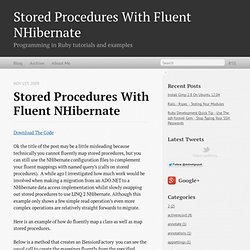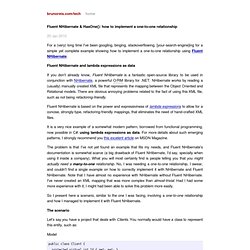

NHibernate Mapping Generator - Home. Orm - Mapping nested components in Fluent NHibernate. How to map a tree in NHibernate - The NHibernate FAQ. Introduction Lately there have been many questions regarding how to best map a tree structure in NHibernate. In this post I'll try to show you various techniques how one can deal with a tree structure.
The code for this sample you can get from here . Domain Model Let's define a very simple domain model for this sample. You could as well replace the class Equipment by e.g. a Person class. Where is my Aggregate? A Aggregate in DDD is defined as "A cluster of associated objects that are treated as a unit for the purpose of data changes . Depending on our Use Cases or User Stories we can define our Aggregate either as that is, the aggregate includes the equipment (which is the root) and its children. Or we could define the Aggregate as follows here only the equipment object is part of the aggregate (it is at the same time the root of the aggregate). In the following I choose the former aggregate (equipment and children). Mapping Let's have a look at the mapping for the Equipment class.
[Test] " as" + Stored Procedures With Fluent NHibernate - Ruby on Rails with Dan Watson. Download The Code Ok the title of the post may be a little misleading because technically you cannot fluently map stored procedures, but you can still use the NHibernate configuration files to complement your fluent mappings with named query’s (calls on stored procedures).

A while ago I investigated how much work would be involved when making a migration from an ADO.NET to a NHibernate data access implementation whilst slowly swapping out stored procedures to use LINQ 2 NHibernate. Although this example only shows a few simple read operation’s even more complex operations are relatively straight forwards to migrate. Here is an example of how do fluently map a class as well as map stored procedures. Below is a method that creates an ISessionFactory you can see the usual call to create the mappings fluently from the specified assembly, and you can see we can also add Hbm Mappings for the QuestionGroup class.
<? Matt Millican - Executing Stored Procedures from Fluent nHibernate. Most of my current development projects use Fluent nHibernate as my ORM (Object Relational Mapping) to connect to databases.

For the most part, I love it. I love being able to "easily" connect my objects to tables in the database, taking advantage of lazy loading, etc (the reasons go on). The one downfall I've seen with Fluent nHibernate specifically is running views, functions and stored procedures on SQL Server. Although in Web development these days, I really don't like using them, there's times they seem necessary, or at least make things much easier. Our Business Intelligence development uses stored procedures and views heavily also. I wrote the stored procedure to follow our standard conventions and tested to verify it works correctly.
SqlDelete("exec stored_proc_name ? "). The "exec stored_proc_name ? " As a side note, there's also SqlInsert() and SqlUpdate() methods available, but we're not using those yet. PS. Fluent NHibernate & HasOne(): how to implement a one-to-one relationship - brunoreis.com/tech.
For a (very) long time I've been googling, binging, stackoverflowing, [your-search-engine]ing for a simple yet complete example showing how to implement a one-to-one relationship using Fluent NHibernate.

Fluent NHibernate and lambda expressions as data If you don't already know, Fluent NHibernate is a fantastic open-source library to be used in conjunction with NHibernate, a powerful O/RM library for .NET. NHibernate works by reading a (usually) manually created XML file that represents the mapping between the Object Oriented and Relational models. There are obvious annoying problems related to the fact of using this XML file, such as not being refactoring-friendly.
Fluent NHibernate is based on the power and expressiviness of lambda expressions to allow for a concise, strongly-type, refactoring-friendly mappings, that eliminates the need of hand-crafted XML files. The scenario Let's say you have a project that deals with Clients. And that's it! Adding some relationships And that's all.
C# - Fluent nHibernate mapping problem.